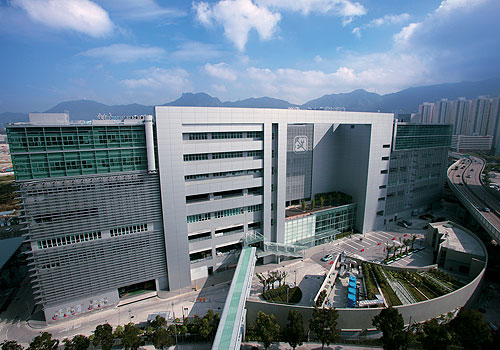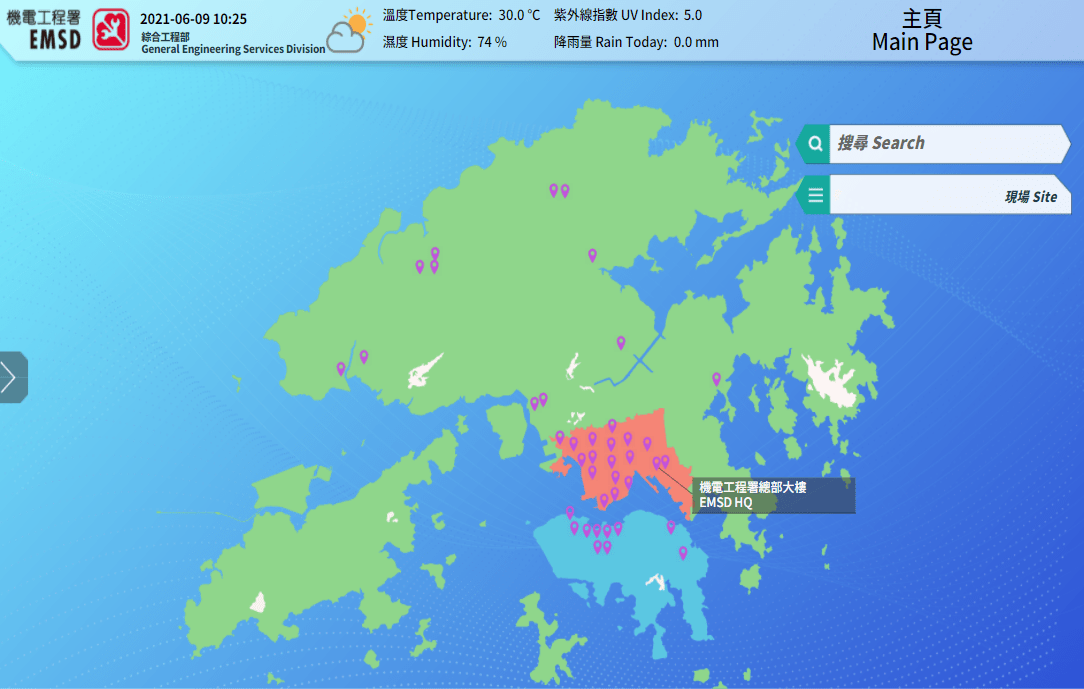Electrical and Mechanical Services Department, HKSAR
Hong Kong, Hong Kong


Building Portfolio:
The Electrical and Mechanical Services Department (EMSD) of the Hong Kong Special Administrative Region (HKSAR) manages E&M facilities for government venues in Hong Kong. Among the venues, over 400 have an annual electricity consumption of 500,000 kWh and above. In possession of the huge amount of building operational and energy data from a wide range of systems, EMSD started to develop an integrated Building Management System (iBMS) on an unprecedented scale. As expected, the buildings are of various ages and equipment conditions. Thus, in the beginning of the project, iBMS guidelines and specifications were formulated to standardize the data collection requirements. A checklist was developed for standard project submission mandating BTL certificates and PIC statements for newly installed products to assure quality and conformance in fulfilling the iBMS connection. In 2019, EMSD set up its first iBMS platform at the Headquarters, integrating operational data from widely dispersed buildings at the city level. Targeted buildings were prioritized based on their electricity consumption and readiness for connection. The platform offered opportunities to enhance system reliability to enable benchmarking and linking up with big data analysis with an aim to achieve a better building performance. This project improved the building data structure which rendered support to Hong Kong towards a smart city.
Familiarizing Problems:
Several unique problems were encountered during the course of development. With the increasing age of a building, there often appeared at different degrees of inconsistencies on BMS settings due to past retrofits and deterioration of the existing system. In some buildings, communication through BACnet might not have been possible because of the use of proprietary protocol. Interoperability became a critical issue for a successful integration. Meanwhile, the iBMS network architecture required continuous review to accommodate the quick expansion of the system when more buildings were being connected. The method to establish a remote BACnet network was another challenge. The experience in our first trial of applying Foreign Device Registration (FDR) for the connection to the central iBMS workstation raised troubles on the manual update of the network address when testing with third party protocol analyzers. This hindered future migration to any new system platform. Since iBMS data was built up through direct communication with BACnet devices at the venue level, the variety of object naming conventions and trend log/alarm settings at each venue would impair the quality and the application of iBMS. Another challenge in this project was the requirement to export iBMS data to our Regional Digital Control Centre (RDCC), which consisted of an in-house developed data server for further machine learning and Artificial Intelligence (AI) applications.
Collaborative Working:
Making iBMS a sustainable solution to the department, EMSD took advantage of the vendor neutral environment under BACnet in 2020 to engage the current system integrator to review the iBMS architecture and carry out server upgrades to cope with the continuing expansion. Enhancement included making available a BACnet router with the Network Address Translation (NAT) function at the venue level such that all BACnet devices resided on the same IP subnet i.e. virtual devices at venues could share the building data with the iBMS platform located at the Headquarters under the same IP network. Despite the data scope not covering sensitive information, security on data transmission was always a primary concern, especially for critical government venues delivering essential public services. To achieve a secured converged network, a Virtual Private Network (VPN) configuration was used to ensure cyber security. The use of a dedicated VPN IPSec tunnel allowed for the segregation of venues per owner basis which further enhanced data privacy. The cyber security of the iBMS system architecture was further proven upon satisfactory testing through a Security Risk Assessment and Audit (SRAA) in accordance with the government IT security policy. An independent Certified Information System Auditor was appointed and it was concluded that the connection method could be similarly applied for future venues. The abuse of a vendor’s proprietary properties led to the absence of meaningful representation of a data object when communicating with other vendors’ BACnet devices, which could ruin the iBMS system quality. To resolve these issues, engagement of the frontline staff who performed daily operation and maintenance of the BMS at the venues was crucial to the success. Site visits were conducted to enhance colleagues’ understanding of how to implement necessary modifications on the BMS for a better iBMS. The iBMS team also convened meetings and workshops to collaborate with key players in this project to promote the importance of BACnet compliance. As a baseline, BACnet standardized data structures shall be strictly followed. Other requirements include (a) object name should be properly defined according to the point abbreviation presented in the iBMS guidelines, (b) simple number assignment with cross reference to proprietary filed should be avoided, (c) other than input/output (I/O) objects, all software points are required to be BACnet compatible to achieve full compatibility, and (d) for venues with genuine difficulties, new dedicated building controllers for iBMS might be considered to ensure object properties, including naming convention, alarm and trending, are properly set.
Successful Outcome:
Through the learning process in this project, the department is now able to attain the optimized iBMS configuration which best adapts future changes on any equipment replacement or alteration works. iBMS provides handy access to essential operating information on a unified platform for everybody’s use. A common Graphic User Interface (GUI) was developed to reduce misunderstanding by adopting same choices of words and graphic icons, i.e. a common look and feel. The standard graphical presentation enables sharing of information across buildings with minimal difficulty. To further enhance the user experience, LDAP user authentication was arranged for centralized login for colleagues in EMSD which eliminated the need for regular updating due to staff movement. In this project, we established a database connection at the server level with the data lake under RDCC to enable data exchange automatically by schedule. Data cleansing and validation were then performed before proceeding to big data analysis and AI application by RDCC. With sufficiently large volumes of data, it is now possible to perform benchmarking with minimal efforts, find ways to improve energy efficiency, and enhance daily operational routines and system optimization. Real time data and alarm notification with RDCC has been tested and proven to be achievable through RESTful Web Service Interface following ASHRAE 135-2016 Annex W. This enables machine learning from historical and real time data to analyze failure patterns which assist in the development predictive maintenance tools. With the solid foundation of the iBMS platform, EMSD will connect more venues to the iBMS and the system is expected to double by 2023.
